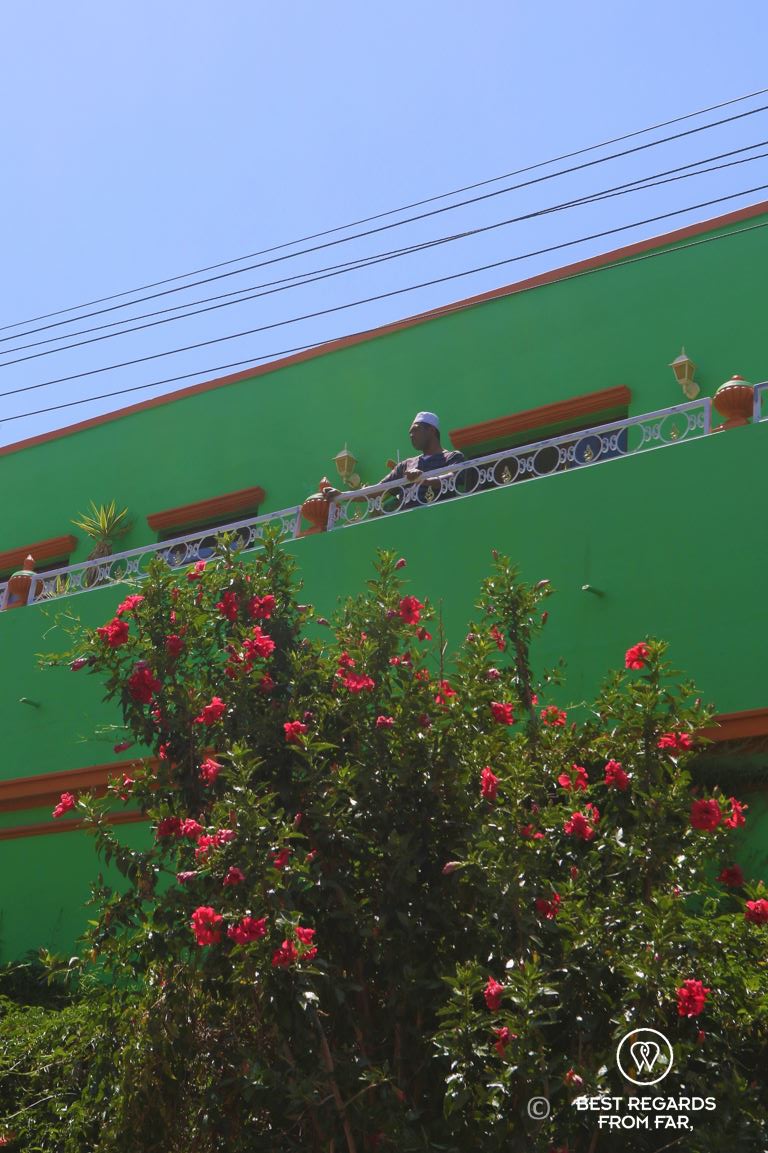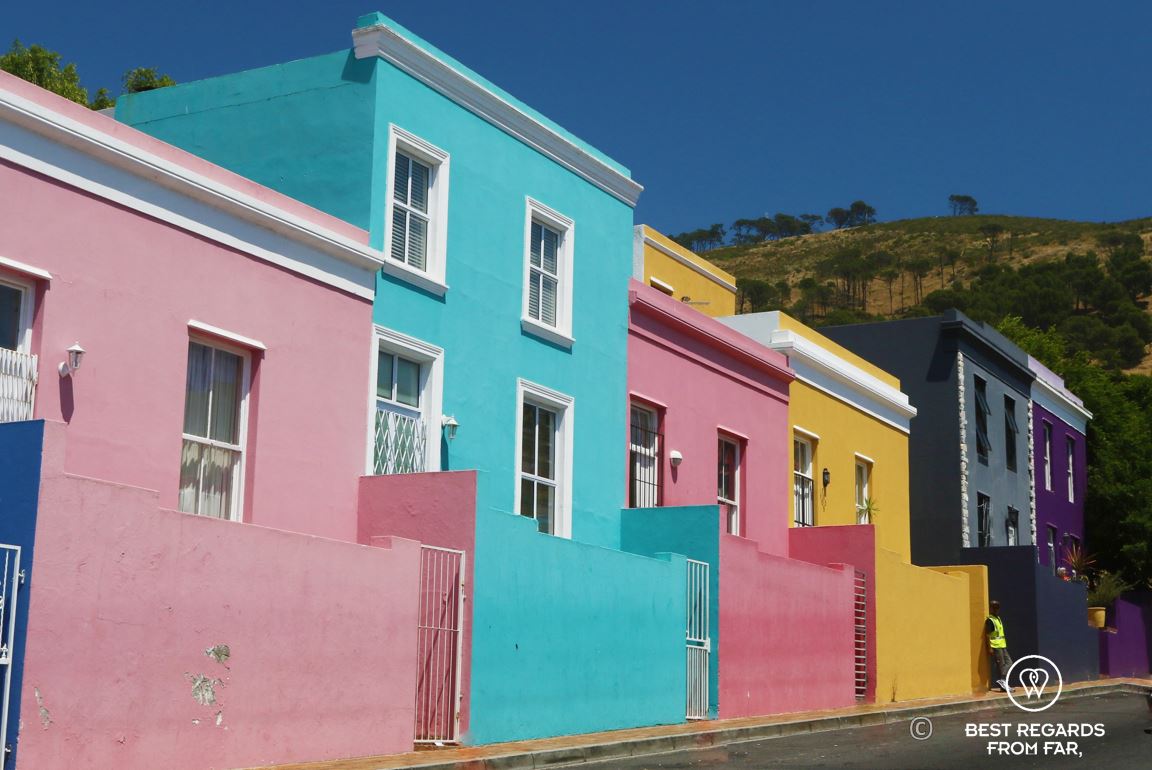Article updated on July 15, 2023
Text & Photographs: Claire Lessiau & Marcella van Alphen
Bo-Kaap is a historic and small residential area of Cape Town built mostly between 1760 and 1840 that became home to many Muslims and freed slaves. Today with its brightly painted houses, it is one of the most instagrammable districts of Cape Town and a must-visit, also to taste its flavourful Cape Malay cuisine!
How did Bo-Kaap become the Muslim area?
Under the British occupation of the Cape that started in 1795, the hilly slope above Cape Town (the “Bo-Kaap” in Afrikaans) was made of modest single storey flat-roofed houses for hire. Occupants were immigrant craftsmen of European origins.


With more slaves than colonisers in Cape Town when slavery was abolished in 1834, the pressure for cheap housing was strong. Many freed slaves settled in what will become to be known as District Six while others moved to Bo-Kaap, taking over these small houses from the immigrants, who themselves had moved to the suburbs. Most of them were Muslims from the Malay Archipelago – the islands between India and Australia. Some were slaves who were Muslims or who converted to Islam that was seen by them as a religion of freedom. Some were political or religious leaders banned by the VOC to the Cape Colony as they opposed its control in their countries of origin. Political exiles such as Sheikh Yusuf who resisted the Dutch occupation in the East Indies arrived at the Cape in 1694 and is credited with having brought Islam to South Africa. Imam Abdulla Kadi Abdus Salaam of Indonesia known as Tuan Guru (“Mister Teacher”) was sent to Robben Island by the Dutch as a religious prisoner, and founded the Auwal Mosque in Bo-Kaap – still running today – as well as the first Muslim school after his release in 1793. Today their legacies survive in Bo-Kaap and they are honoured on street murals.


In the mid-1960s, the apartheid government declared parts of Bo-Kaap as a ‘Malay Group Area’, a sub-group of the “coloured” category while it forcefully displaced the Cape Malays of District Six to the Cape Flats.
Today Bo-Kaap is flourishing as a proud and prominently Muslim district with a mixed and vibrant social life and a strong sense of community.


Corner stores: more than just convenience
In Bo-Kaap, many street corners house convenient stores that are a key element of the local community life. Step in and you will find household goods, food, and some koeksisters and samosas. More than just shops, these are meeting places. One of the most popular ones is Rose Corner Café at the corner of Rose and Wale streets, that has been owned by the same family for more than 45 years. It is not uncommon in Bo-Kaap to pass down a trade such as tailoring and cooking, or a store, from generation to generation. Many retail outlets are long-established family businesses just like the famous Atlas Trading Centre spice store and as such they foster a sense of community.



What is Cape-Malay?
Despite the diversity of their origins, from East Africa to Malaysia, Madagascar, Indonesia, India, Sri Lanka, The Philippines… this group of Muslim people came to be known as “Cape Malay”.
Because the Cape Malay were brought to the Cape Colony as slaves to the Dutch settlers, they had to communicate in Afrikaans and this is the prime language of Cape Malays today.
Bo-Kaap is the most famous Cape Malay district in South Africa where the thriving community adds colours not only to the walls of their houses but also to the character of the mother city.


The basics of Cape-Malay food
When incoming slaves were stripped down of all their belongings and even their names and family ties, food was one of the last remaining markers of their identity, and as such conveys a special flavour here in Cape Town. Yellow rice, samosas, dhaltjies (deep-fried ball-shaped snacks made of chickpea flour, spinach, onion and turmeric), and rotis are part of the favourites. Dutch influences reappear with the delicious koeksisters while Cape Malay specialties have become a symbol of South African cuisine like bobotie. The Cape Malay curries are flavourful and less spicy that their Indian versions. If you want to know more about Cape Malay food: click here.


The deep meaning behind the colours of Bo-Kaap
None! Even though many tourist guides or blogs will find a reason for these colours, there is absolutely no meaning. Actually, if you visit Bo-Kaap regularly, you will notice that house owners change colours about every three years.
Inhabitants simply wanted to give a joyful look to the neighbourhood and paining their façades with cheap paint of vivid colours has made the Bo-Kaap so characteristic and photogenic.



Why is it a miracle that Bo-Kaap is still standing?
During the apartheid, the Bo-Kaap was almost razed down by the City Council.
More recently, because of its prime location, the Bo-Kaap has become a target for real-estate developers.
If the Bo-Kaap is still standing today it is mostly thanks to its Cape Malay community who is very attached to its neighbourhood and defends it passionately. Bo-Kaap contains the greatest density of pre-1850 buildings in South Africa, making it the oldest residential area in the country and in Cape Town. Thanks to the persistence of its inhabitants, Bo-Kaap is in the process of becoming a UNESCO World Heritage Site so that the neighbourhood is not tampered with and retains its cultural specificities.

Travel tips:
- Check out this interactive map for the specific details to help you plan your trip and more articles and photos (zoom out) about the area! Here is a short tutorial to download it.
Like it? Pin It!
For more in Cape Town:










Interesting post.
Thanks!
This place looks absolutely fascinating! I’d love to go exploring there. I love the colours and the atmosphere.
Alison
And the food… Thanks Alison – let us know when you make here in Cape Town and we would love to take you around!
Oh I will! Thank you!
Wonderful photos, especially the one with the beautiful old car in front of those bright houses! I remember being delighted by this unexpected neighbourhood. I would love to visit again.
Thanks Caroline for your sweet comment- much appreciated. Did you visit South Africa extensively?
In 2008, we spent time in Cape Town and the Western Cape. In 2012, we visited Kruger NP, Kosi Bay area, Hluhuwe Imfolozi, Drakenberg. We were super impressed with everything we saw/experienced. I also loved Namibia.
You have seen a lot in South Africa indeed! Can’t agree more. We are both in love with this country. We still need to make it to Namibia… Soon I hope!
You’ve taught me much that I didn’t know about Cape Town. Thanks for the great photos to explain the dialogue. Now, I want to return and see what you saw.
Thanks for the compliments. We have a couple more articles still about Cape Town that are about to be published, highlighting also the impact the salve trade had on the country. I’m sure you’ll enjoy them as well. We are starting organizing trips in South Africa – let us know if you are ever interested 🙂